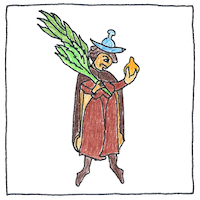Hillel II,
Maimonides
astronomy

|
Hebrew calendar
The beginning of the Hebrew calendar predates Hillel the Nasi. In the sixth century BCE, during their captivity in Babylonia, the Jews adopted the Babylonian names of months. Before this, their months were numbered, not named. The Babylonian calendar, like the Hebrew calendar, was lunisolar. Gradually, over hundreds of years, teachers switched from direct observation of agricultural events to determine when to add an extra month to the year, and, to determine the start of each month, from direct observation of the first crescent moon to adding synodic months from the first year of the world, Anno Mundi 1, thought to have occurred on the sixth of September 3761 BCE just before midnight, Jerusalem time. In 1178, Maimonides codified rules for calculating the points and periods.
Interesting aspects
It’s good that holidays and rituals are kept in synch with the revolutions of the earth, moon, and sun, but there are many interesting aspects to this calendar such as counting years from Anno Mundi 1, that is, from 3761 BCE in the Proleptic Gregorian calendar, having each year start on Rosh Hashanah, near the solstice, the time of year when God created Adam and Eve, counting a year by months and not by days, having each day start at sunset and so having no fixed length in minutes having each month start with a new moon, having a new moon start when its crescent is first visible, calculating a synodic month to be 29 days, 12 hours, and 793 eighteenths of a minute, having any extra month start before the last month, so that the first month would be in the spring having sunset occur when three medium-size stars are visible, having different opinions as to when the date changes, starting the day either at dawn or at sunrise, having an hour be one-twelfth of the time from sunrise to sunset, not a fixed number of minutes, this being shorter in winter and longer in summer, dividing the hour into 1080 parts having a seven-day week, not coincidentally the number of days that God took to create the world, and having Sunday be the first day of the week. Having a calendar is having good reasons for all these decisions, and then sticking to it.
Inaccuracies
To correct for the fact that twelve lunar months fall short of the days needed for the earth to orbit the sun, every two or three years the year gets an extra lunar month (that is, for seven of every nineteen years comprising the Metonic cycle); however, this year still falls short one day (compared to the Gregorian calendar) every 231 years, so what the heck? One can get really serious about the synodic month being about six-tenths of a second too long. The actual length of the synodic month varies by about thirteen and a half hours, but it turns out that the tides are making the month longer while also slowing earth’s rotation, so that no calendar is staying in synch.



That there are twelve signs of the zodiac, twelve months of the year, twelve sons of Jacob, and twelve tribes of Israel should not be lost to the numerologists among us.
OK, well . . . we need a few years with thirteen months to keep our months in synch with our years.
See also in The book of science:
Readings in wikipedia:
Other readings: